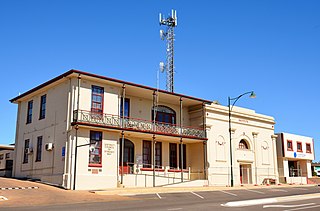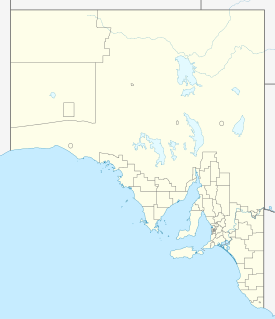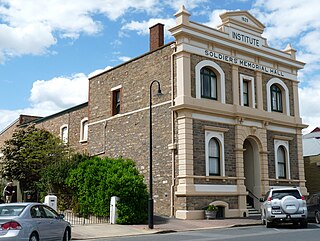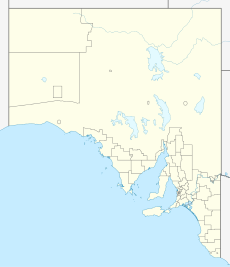
The town of Clare is located in South Australia in the Mid North region, 136 km north of Adelaide. It gives its name to the Clare Valley wine and tourist region.

The District Council of Streaky Bay is a local government area in South Australia located on the Eyre Peninsula. Streaky Bay is the main population centre of about 1200 people serving an agricultural district based on farming wheat and other cereal crops, sheep, supplemented by fishing and tourism industries. The district covers an area of 6,251.1 square kilometres with a population of 2,074 people in 2016, according to the Australian Bureau of Statistics. Mayor of Streaky Bay is Travis Barber.
The District Council of Waikerie was a local government area in South Australia from 1914 to 1997, centring on the town of Waikerie.

The District Council of Yatala was a local government area of South Australia established in 1853 and abolished in 1868.

The District Council of Wilmington was a local government area in South Australia, centred on the town of Wilmington from 1888 to 1980.

The Hundred of Clare is a cadastral unit of hundred in the northern Mount Lofty Ranges centred on the town of Clare. It is one of the 16 hundreds of the County of Stanley.

The District Council of East Torrens was a local government council of South Australia from 1853 to 1997.
The District Council of Port Broughton was a local government area in South Australia from 1892 to 1997 seated at the town of Port Broughton.

The District Council of Mobilong was a local government area in South Australia from 1884 to 1977.

The District Council of Mount Pleasant was a local government area in South Australia from 1935 to 1997. The council seat was located at Mount Pleasant.
The District Council of Truro was a local government area in South Australia from 1876 to 1991.
The District Council of Willunga, was a local government area in South Australia seated at Willunga from 1853 until 1997.

The District Council of Hall was a local government area in South Australia from 1878 to 1935.

The District Council of Blyth was a local government area in South Australia from 1872 to 1987 seated at Blyth in the Mid North.

The District Council of Balaklava was a local government area seated at Balaklava in South Australia from 1877 to 1983.

The City of Woodville was a local government area in South Australia from 1875 to 1993, seated at the inner north west Adelaide suburb of Woodville.

The District Council of Kondoparinga was a local government area in South Australia from 1853 until 1935, at which point the council lands and resources formed the heart of the new District Council of Meadows.

The District Council of Strathalbyn was a local government area in South Australia centred on the town of Strathalbyn from 1854 until 1997. From 1868 the township itself was locally governed by the Corporation of Strathalbyn but that entity was amalgamated back into the district council in 1976.

The District Council of Kapunda was a local government area in South Australia from 1866 to 1996. The Kapunda town corporation was formed a year earlier in 1865 and ultimately amalgamated into the district council.

The District Council of Upper Wakefield was a local government area in South Australia centred on the town of Auburn from 1854 until 1970.







